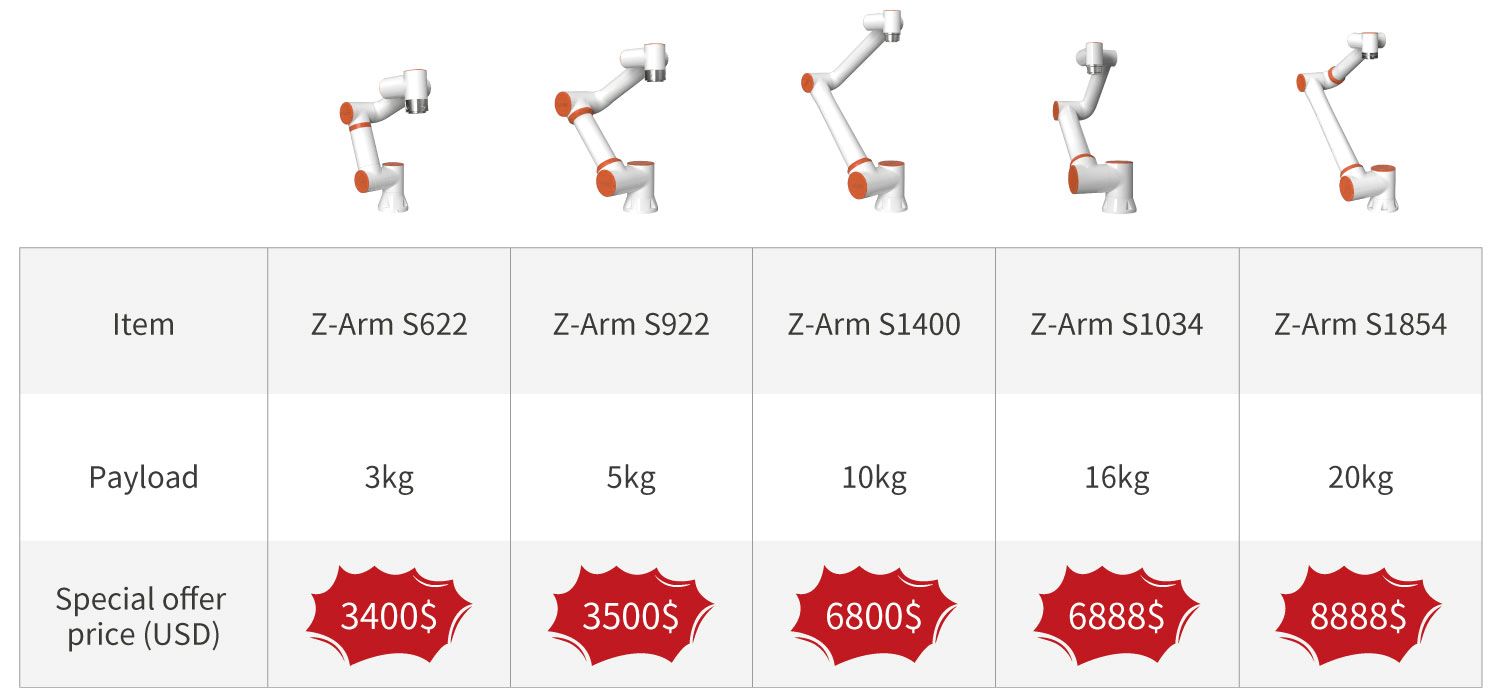
How Much Do Collaborative Robots (Cobots) Cost in 2025?
A Comprehensive Guide
Collaborative robots, or cobots, have revolutionized industries by bridging the gap between human workers and automation. Unlike traditional industrial robots, cobots are designed to work alongside humans safely, making them ideal for small-to-medium businesses and large enterprises alike. But one question we hear often is: “How much do cobots cost?”

The short answer? Prices typically range from $3000 to $30,000+ depending on specifications, brand, and application requirements. However, understanding what drives these costs is critical to making an informed investment. In this guide, we’ll break down the factors influencing cobot pricing and help you determine which model aligns with your needs.
Why Cobots? A Quick Recap
Before diving into costs, let’s revisit why cobots are gaining traction:
- – Safety: Built with sensors and force-limiting technology, cobots operate safely near humans.
- – Flexibility: Easy to program and redeploy for tasks like assembly, pick-and-place, quality inspection, and more.
- – ROI: Affordable automation for SMEs, often paying for themselves within 12–24 months.
But their value doesn’t erase the need for careful budgeting. Let’s explore what shapes cobot pricing.
Key Factors Affecting Cobot Costs
- Payload Capacity
Payload—the maximum weight a cobot can lift—is a primary cost driver.
- – Low payload (1–5 kg): Ideal for lightweight tasks (e.g., electronics assembly). Prices start around $3,000–$25,000.
- – Medium payload (5–10 kg): Suits packaging, machine tending. Expect $4,000–$10,000.
- – High payload (10+ kg): Used in heavy material handling. Costs exceed $10,000.
Higher payloads require stronger materials (e.g., aluminum alloys) and advanced motors, increasing production costs.
- Technical Complexity
Not all cobots are created equal. Features like precision, speed, and advanced functionality impact pricing:
- – Repeatability: Cobots with sub-millimeter precision (±0.1mm) cost more due to high-end encoders and sensors.
- – Number of Axes: A 6-axis cobot (human-arm-like flexibility) is pricier than a 4-axis model.
- – Advanced Controllers: Models with AI-driven path optimization or machine vision integration command premium pricing.
- Brand Reputation and Support
Established brands like Universal Robots, Techman Robot, and ABB often charge more due to proven reliability, global service networks, and compliance certifications. Newer brands may offer lower prices but could lack long-term support or safety certifications.
- Add-Ons and Accessories
A cobot’s base price rarely includes everything you need. Common add-ons include:
- – End-of-Arm Tools (EOAT): Grippers, suction cups, or specialized tools ($1,000–$10,000).
- – Vision Systems: Cameras for object detection or quality checks ($3,000–$15,000).
- – Software Packages: Advanced programming interfaces or analytics tools, usually provide free software system ($0–$8,000).
- Application-Specific Customization
While cobots are “plug-and-play,” complex applications (e.g., welding or lab testing) may require:
- – Custom EOAT Design: Tailored grippers or sensors.
- – Safety Modifications: Additional laser scanners or fencing for hazardous environments.
- – Integration Services: Third-party engineers to sync the cobot with existing machinery.
Custom work can add 20–50% to the total cost.
- Safety and Certifications
Cobots must comply with regional safety standards (e.g., ISO 10218, ISO/TS 15066). Models certified for use in regulated industries (medical, aerospace) undergo rigorous testing, raising production costs.
- Software Ecosystem
User-friendly interfaces and open-source platforms (e.g., ROS integration) add value but also cost. Some brands lock advanced features behind subscription plans.
- Maintenance Cost
There is an necessary cost for cobot maintenance, as it may be not so well-functioned due to the increase of using time. Including the replacement of parts(motors,encoders,drivers), which cost ($0–$1,000).
Cobot Price Ranges: What to Expect
Here’s a simplified breakdown of Collaborative Robots(Cobots) Cost in 2025:
| Tier | Price Range | Use Cases
| Entry-Level | $30,00–$10,000 | Light assembly, education, prototyping|
| Mid-Range | $10,000–$30,000 | Packaging, CNC tending, lab automation|
| High-End | $30,000+ | Heavy payloads, precision welding, R&D|
Maximizing Your Cobot Investment
To avoid overspending:
- Define Your Needs: Start with a clear task list. Do you need 0.1mm precision or basic pick-and-place?
- Calculate ROI: Factor in labor savings, error reduction, and uptime improvements.
- Consider Total Costs: Include installation, training, and maintenance.
- Future-Proof: Choose a scalable model that adapts to new tasks.
Final Thoughts
While cobots represent a significant upfront investment, their flexibility and rapid ROI make them a game-changer for businesses of all sizes. By understanding what drives pricing—payload, features, brand, and customization—you can select a cobot that fits your budget and operational goals.
Suggestions
If you are considering reducing the production cost, then Chinese cobot is an ideal choice, as it’s relatively cheaper than cobots from other countries, and there are plenty of well-known cobot brands, providing various cobot models range from 1kg to 30kg, which can meet most of the using requirements.
If you are
Ready to explore options? Hitbot Robotic offers tailored cobot solutions for every industry. [Contact us] for a free consultation!
